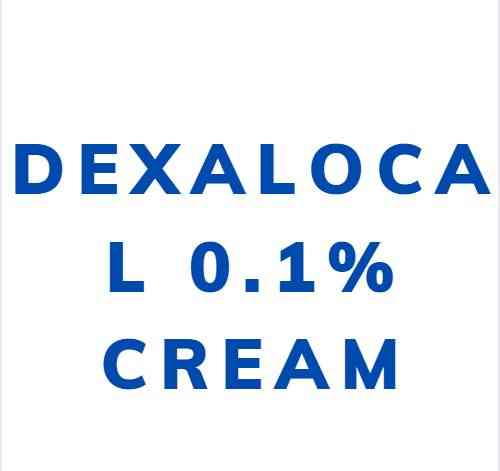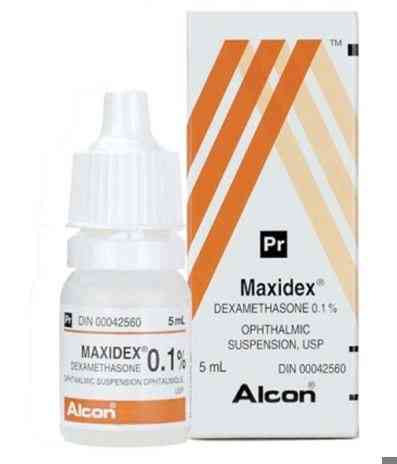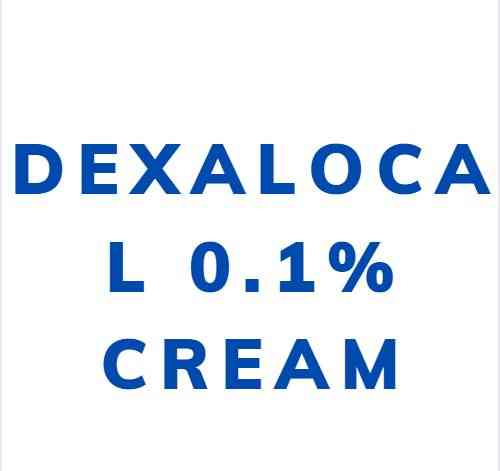What are the uses of Dexalocal?
Dexamethasone is used to treat conditions associated with infections, immune system disorders, and hormone deficiencies. These conditions include:
Infections in general, and is used specifically to reduce swelling (edema) associated with tumors of the spine and brain, and to treat eye infections.
Allergic reactions.
Rheumatoid diseases, such as rheumatoid arthritis, rheumatoid spondylitis, lupus, and others.
Skin diseases, such as pemphigus, Stevens-Johnson syndrome, various types of skin infections, and severe psoriasis.
Attacks of multiple sclerosis and myasthenia gravis (in English: Myasthenia gravis).
Previous treatment for chemotherapy, to reduce inflammation and side effects associated with cancer drugs, such as nausea and vomiting.
Adrenal insufficiency.
Some respiratory problems, such as asthma.
Some types of cancer, such as leukemia and lymphoma.
Improving appetite in cancer patients with severe appetite problems.
Diagnosis of Cushing s syndrome.
Contraindications of Dexalokal
Dexamethasone should not be used by people who are hypersensitive to it, or to any of the other ingredients used in its manufacture, and it should not be used by people who suffer from a fungal infection anywhere in the body.
It is also forbidden to use dexamethasone by people with cerebral malaria (in English: Cerebral malaria), and it is forbidden to give patients who use dexamethasone in immunosuppressive doses, live vaccines, or live attenuated vaccines.
How to use Dexalocal
It is recommended to follow the following advice when using dexamethasone:
Take dexamethasone with food to reduce stomach upset, and with a full glass of water, preferably in the morning if possible, to avoid sleep problems at night.
Drink 2-3 liters of water daily, unless your doctor prescribes it.
Maintain hygiene and sterilization, to avoid the risk of infectious diseases when using dexamethasone for long periods.
Use sunglasses when using decamethasone eye drops or ointments, as they increase eye sensitivity
What is DEXALOCAL 0.1% ?
DEXALOCAL 0.1% Cream is a topical formulation containing dexamethasone, a synthetic corticosteroid known for its anti-inflammatory properties. This cream is specifically designed for the treatment of various inflammatory skin conditions. Dexamethasone works by reducing inflammation, redness, and itching, providing symptomatic relief to patients suffering from conditions such as eczema, dermatitis, and psoriasis.
The formulation contains 1 mg of dexamethasone per gram of cream, delivering a low concentration that is effective for localized treatment. DEXALOCAL 0.1% is indicated for patients who require a gentle yet effective approach to manage inflammation without significant systemic absorption. This makes it suitable for use in sensitive areas of the skin, such as the face and groin, where the skin barrier may be more permeable.
Topical corticosteroids like DEXALOCAL 0.1% provide a targeted therapeutic effect, allowing for localized action with minimal systemic side effects. This is particularly advantageous for patients seeking treatment for acute exacerbations of their skin conditions, as it offers a rapid onset of action while limiting the risks associated with oral corticosteroid therapy.
Patients using DEXALOCAL 0.1% Cream should be counseled on proper application techniques. The cream should be applied in a thin layer to the affected area, typically one to three times daily, as directed by a healthcare provider. Patients should avoid occlusive dressings unless specifically instructed, as this can enhance absorption and increase the likelihood of side effects.
Overall, DEXALOCAL 0.1% Cream represents an effective option for managing localized inflammation in dermatological conditions. Its formulation allows for safe, targeted treatment, making it an essential medication in dermatological practice.
How to use DEXALOCAL 0.1% ?
Administration and Dosage Guidelines for DEXALOCAL 0.1% are crucial to ensuring effective treatment outcomes. The cream is intended for external use only and should be applied to clean, dry skin. Patients are generally advised to apply the cream one to three times daily, depending on the severity of their condition and the healthcare provider’s recommendations.
Before applying DEXALOCAL 0.1%, patients should gently cleanse the affected area to remove any dirt or debris. This preparation step is essential for maximizing the absorption of the medication. After applying the cream, patients should wash their hands thoroughly to prevent accidental transfer to other areas of the body.
Instructing patients on the appropriate amount of cream to use is vital. A small amount of cream should be sufficient to cover the affected area. Patients should be made aware that using excessive amounts does not equate to improved efficacy and may increase the risk of side effects.
Healthcare providers should also monitor patients for any signs of irritation or adverse reactions, especially during the first few applications. If a patient experiences increased redness, itching, or burning sensation, they should contact their healthcare provider for further guidance.
In summary, the administration and dosage guidelines for DEXALOCAL 0.1% are straightforward but vital for achieving therapeutic success. Education on proper application techniques and ongoing monitoring can enhance treatment outcomes.
<
Mode of Action
Mode of Action for DEXALOCAL 0.1% involves the actions of its active ingredient, dexamethasone. As a corticosteroid, dexamethasone exerts its effects by binding to glucocorticoid receptors in the skin cells. This interaction leads to the inhibition of pro-inflammatory mediators, thereby reducing the inflammatory response.
In dermatological applications, dexamethasone effectively decreases the influx of immune cells to the site of inflammation, resulting in reduced redness, swelling, and itching. The local application of DEXALOCAL 0.1% allows for targeted treatment, minimizing systemic exposure and the associated risks of corticosteroid therapy.
Upon application, dexamethasone penetrates the skin layers and exerts its anti-inflammatory effects. This rapid onset of action is beneficial for patients experiencing acute flare-ups of their skin conditions, providing prompt relief from discomfort.
Understanding the mode of action of DEXALOCAL 0.1% is essential for healthcare providers, as it allows them to explain the therapeutic benefits to patients. The ability to manage inflammation effectively is a key component of treating dermatological disorders.
In conclusion, the mode of action of DEXALOCAL 0.1% emphasizes its role as an effective treatment for inflammatory skin conditions. Its localized effects help patients achieve relief while minimizing systemic side effects.
DEXALOCAL 0.1% Interactions
Interactions with other medications are an important consideration when prescribing DEXALOCAL 0.1% Cream. Due to its corticosteroid component, there is potential for interactions with other immunosuppressive agents. The concurrent use of other corticosteroids or immunosuppressive medications may increase the risk of systemic absorption and associated side effects.
Patients should be advised to inform their healthcare provider of all medications they are currently taking, including over-the-counter drugs and supplements. This comprehensive medication review can help identify potential interactions and allow for appropriate adjustments to the treatment regimen.
Furthermore, caution is advised when prescribing DEXALOCAL 0.1% to patients using topical antibiotics or other dermatological products. Combining different topical treatments may lead to either enhanced therapeutic effects or unexpected adverse reactions.
Healthcare providers should also consider any underlying health conditions that may affect drug interactions. For example, patients with a history of gastrointestinal ulcers may require careful monitoring if using corticosteroids, even topically, as these drugs can exacerbate their condition.
In summary, understanding the potential interactions of DEXALOCAL 0.1% with other medications is crucial for optimizing treatment outcomes and minimizing risks. Open communication between patients and healthcare providers can help ensure safe and effective use of this medication.
Dosage of DEXALOCAL 0.1%
Dosing Considerations for DEXALOCAL 0.1% must be tailored to each patient’s specific needs and the severity of their skin condition. Initial dosing typically involves applying a thin layer of cream to the affected area one to three times daily. This frequency can be adjusted based on the patient’s response to treatment.
Patients should be educated on the importance of adhering to the prescribed dosing regimen. Inconsistent use may lead to suboptimal treatment outcomes and prolonged symptoms. If a patient misses a dose, they should apply the cream as soon as they remember unless it is almost time for the next application. In such cases, they should skip the missed dose and resume their regular schedule.
As the treatment progresses, healthcare providers should assess the patient’s condition regularly. If symptoms persist or worsen after several days of therapy, it may be necessary to reevaluate the treatment plan. Patients should be advised to communicate openly with their healthcare provider about their treatment experience.
In conclusion, careful consideration of dosing is essential for maximizing the therapeutic benefits of DEXALOCAL 0.1%. Through patient education and regular monitoring, healthcare providers can help ensure optimal outcomes for those using this medication.
Possible side effects of DEXALOCAL 0.1%
Side Effects associated with DEXALOCAL 0.1% may vary based on individual patient factors, duration of therapy, and the area of application. Common side effects can include localized irritation, burning, stinging, and dryness at the site of application. These effects are typically mild and resolve with continued use of the cream.
However, patients should be made aware of the potential for more serious side effects, particularly with prolonged use. Long-term application of topical corticosteroids like DEXALOCAL 0.1% can lead to skin thinning, striae, and telangiectasia. Regular monitoring is essential to identify these side effects early and make necessary adjustments to the treatment regimen.
Patients should also be advised to report any unusual symptoms, such as persistent redness, swelling, or signs of infection. Early recognition of these side effects can facilitate prompt intervention and prevent complications.
In rare cases, systemic absorption of topical corticosteroids may occur, leading to adrenal suppression or other serious complications. Healthcare providers should educate patients about the signs of systemic side effects and encourage them to seek medical attention if they experience any concerning symptoms.
In conclusion, while DEXALOCAL 0.1% is an effective treatment option, awareness of potential side effects is crucial. Education and monitoring can help manage these risks effectively, ensuring a positive treatment experience for patients.
DEXALOCAL 0.1% Contraindications
Contraindications for DEXALOCAL 0.1% must be carefully assessed to ensure patient safety. The cream is contraindicated in patients with known hypersensitivity to dexamethasone or any of its components. In such cases, alternative therapies should be considered to manage the underlying condition.
Patients with untreated bacterial infections or viral skin infections should not use DEXALOCAL 0.1%, as corticosteroids can exacerbate these conditions by suppressing the immune response. Additionally, caution is warranted for individuals with a history of cutaneous reactions to corticosteroids.
Pregnant or breastfeeding women should discuss the use of DEXALOCAL 0.1% with their healthcare provider, as corticosteroids may have implications for fetal development or nursing infants. The risks and benefits must be weighed carefully in these populations.
In conclusion, understanding the contraindications for DEXALOCAL 0.1% is essential for healthcare providers. A thorough assessment of each patient’s medical history and current medications can help mitigate risks and ensure safe use of this medication.
Storage of DEXALOCAL 0.1%
Storage Requirements for DEXALOCAL 0.1% are vital to maintaining the integrity and effectiveness of the cream. The product should be stored at controlled room temperature, away from direct sunlight and moisture. Proper storage helps prevent degradation of the active ingredient, ensuring that the medication remains effective when applied.
Once opened, DEXALOCAL 0.1% should be used within the timeframe specified by the manufacturer or healthcare provider. Patients should be educated about the importance of discarding any unused or expired cream according to local regulations to prevent accidental exposure or misuse.
Healthcare providers should instruct patients on proper storage techniques, including keeping the cream out of reach of children and avoiding exposure to excessive heat or cold. This education can help ensure that patients use the medication safely and effectively.
In summary, adherence to storage guidelines for DEXALOCAL 0.1% is essential for preserving its therapeutic benefits. By following recommended storage practices, healthcare providers can help maximize the efficacy of this important medication.




